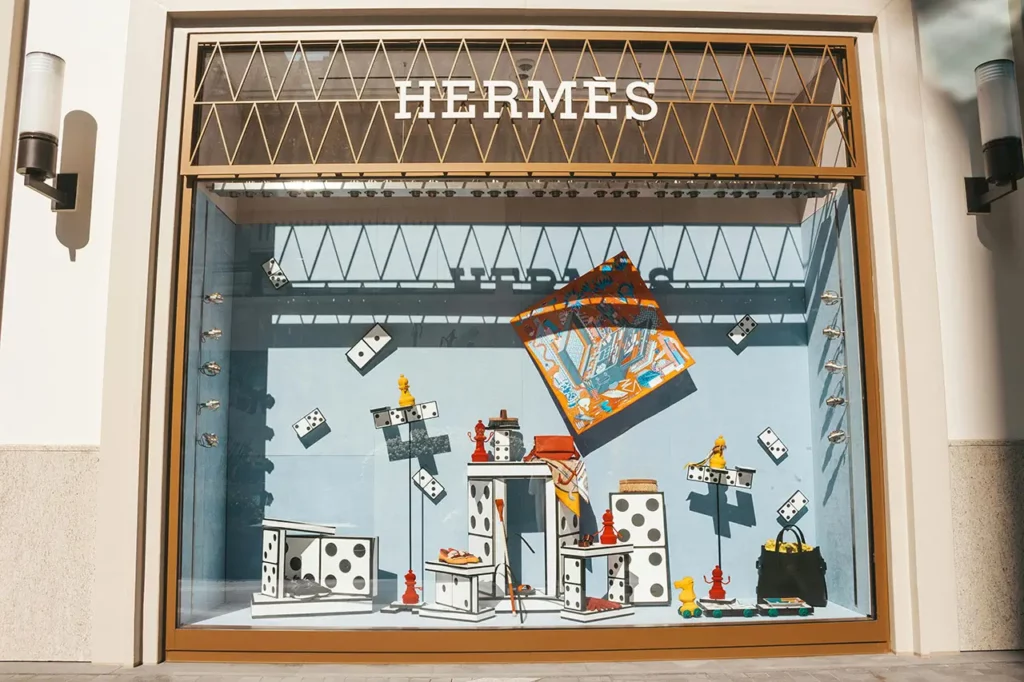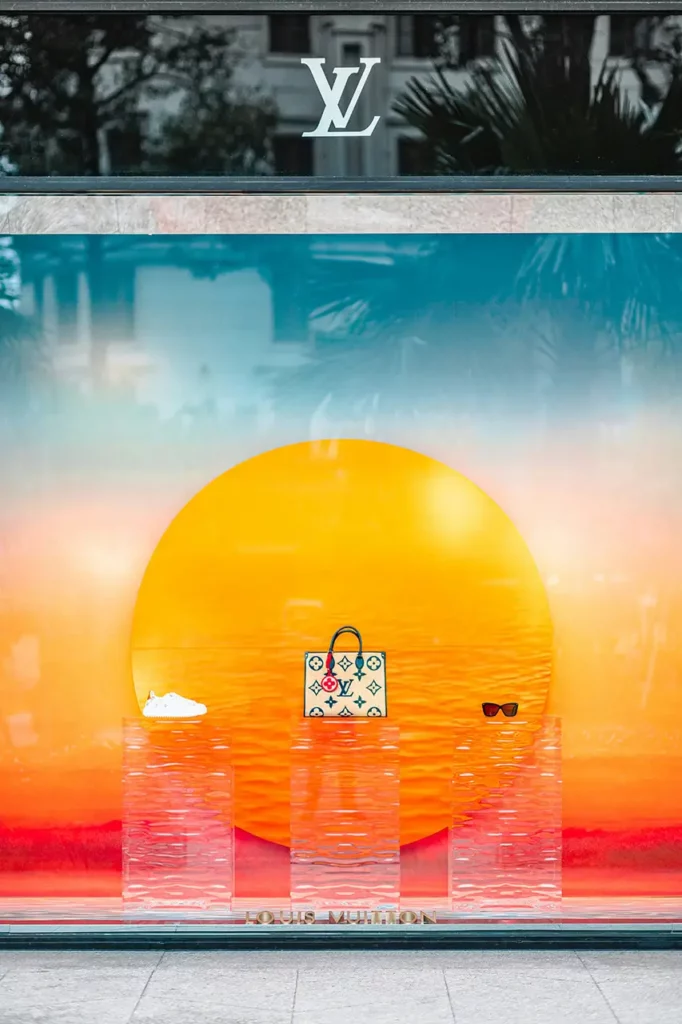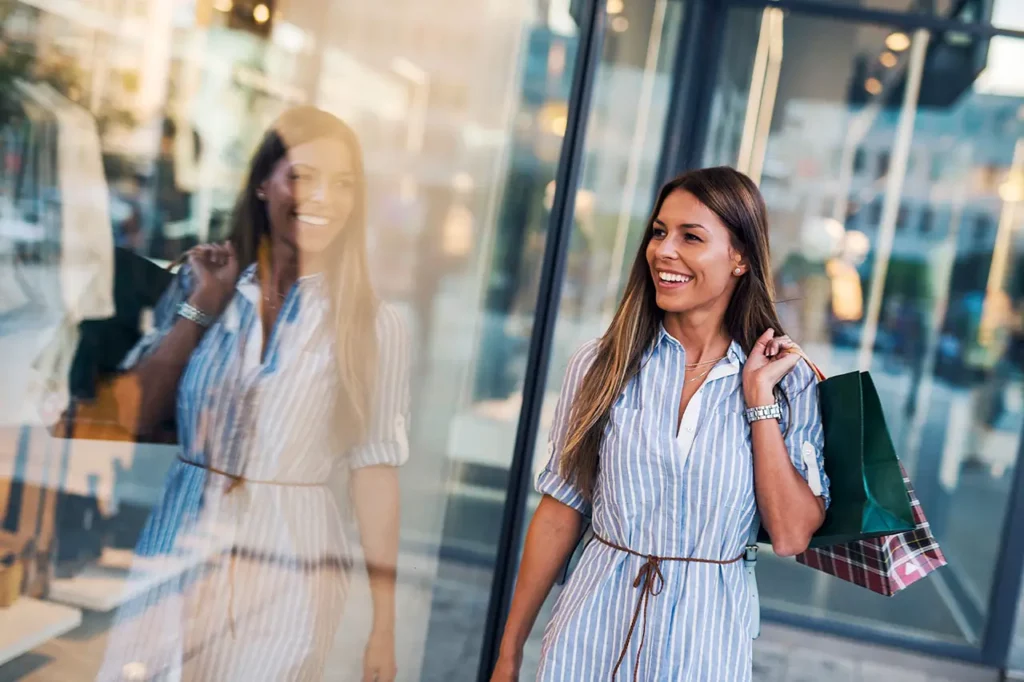The Window Display as an Immersive Experience
In 2025, window dressing is no longer just decorative—it’s a strategic, multidisciplinary discipline. Now more than ever, the display window is an extension of the brand, a space for direct communication between retail and passerby. Brands are investing in creative concepts with strong narratives, backed by technology, to create micro-experiences that stir emotions and drive purchases.
An effective window today doesn’t just show products: it provides context, stirs emotions, and reinforces brand identity. With new sustainable materials, digital tools, and a growing sensitivity toward emotional impact, display windows have become true “urban stages” where every second of attention matters.
A well-designed window display can make the difference between capturing a customer’s attention or losing it in seconds.

Leading Avant-Garde 2025 Window Display Trends
1. Emotional Displays
The future of window displays revolves around emotion. Brands understand that to stand out in a street saturated with visual noise, they must create emotional connections. They use theatrical scenes, visual storytelling, and compositions that tap into memories, desires, and aspirations.
This means building atmospheres that range from nostalgic to futuristic, depending on the brand message. The result: a space that sparks conversations and enhances brand recall beyond the product.
2. Sensory Minimalism
Minimalism is no longer cold. In 2025, brands embrace “sensory minimalism”: clean spaces using textures, soft lighting, subtle sounds, and fragrances to awaken the senses. This helps focus attention on the product, creating an immersive atmosphere without distractions.
Neutral backdrops, directional lighting, and ordered visual elements create a rhythm that invites passersby to stop. The key is balance between simplicity and ambiance.

3. Seasonal and Real-Time Storytelling
Window displays are updated more frequently, integrating themes tied to current events, seasons, or even social trends. Some brands use real-time data—weather, local festivities, or social media trends—to inform the design.
This strategy boosts local engagement, reinforces timeliness, and encourages more frequent visits to physical stores.
4. Tech Integration: Digital Signage and Extended Reality
Immersive technology is transforming window displays. Digital signage—LED screens, videowalls, interactive content—lets brands dynamically and personally change what’s shown.
Extended reality (XR), including augmented and mixed reality, brings displays to life via apps or even without devices, using sensors or projections. Some brands now offer guided virtual tours, product trials through the glass, or scenes that respond to pedestrian movement.
New technologies allow window displays to change in real time and interact with the public on a personalized level.
Innovative Materials and Visual Sustainability
Sustainability now influences display design at its core. It’s not just about promoting eco-responsibility—it’s about applying it to every detail, from recycled cardboard and reused fabrics to plant-based inks and biodegradable structures.
Sustainable materials also offer a unique visual identity. Imperfection, craft, and handmade aesthetics hold value—and resonate with an audience increasingly aware of environmental impact.
In the coming years, we’ll see window displays built with sustainable materials that both decorate and communicate ecological awareness.

User Psychology: Capturing Attention and Driving Action
A strong window display triggers an immediate mental process. In just three seconds, the brain decides whether something deserves more attention.
To succeed, the design must activate “positive friction points”:
Visual curiosity
elements that spark questions or controlled surprise.
Emotional identification
aesthetics aligned with the audience’s values and aspirations.
Visual rhythm
hierarchical structure guiding the eye toward the key product.
The emotions activated in the window must be echoed inside the store to ensure narrative coherence and a seamless brand experience.
The future window display will be an emotional space where design connects with consumer identity.

Case Studies: Real Inspiration for Spectacular Displays
Hermès: Ephemeral Architecture and Visual Poetry
Hermès takes window displays into a deeply artistic and reflective space. A strong example of this is their seasonal display shown in next video. The scene combines geometry and motion in pastel tones, with every element placed with architectural intent, creating serenity and balance.
Hermès builds a narrative without words: floating platforms, slowly spinning spheres, and structures reminiscent of contemporary art galleries. The product isn’t the centerpiece—it blends naturally into the visual choreography. It’s not just display—it’s an emotional experience.
Their sculptural aesthetic and use of negative space amplify the product’s presence without being obvious. Hermès turns the window into a creative universe where design, precision, and poetry merge in a minimalist yet powerful spectacle.
Dior: Magical Scenography and Narrative Luxury
Dior continues to redefine window dressing as a high-impact artistic manifestation. A standout example is shown in this video, where the boutique facade becomes a majestic, hypnotic light installation.
A golden tree of stars, lights, and embossed textures—a luxurious reinterpretation of celestial symbols—frames the boutique like a dreamlike temple. The aesthetic blends tradition, elegance, and seasonal sophistication, reinforcing Dior’s status as a leading maison.
Dior shows how powerful visual narratives can spill beyond the glass, building emotional connections with the city and its people. The window becomes an emotional and architectural gesture, elevating luxury into a cultural experience.
Louis Vuitton: Visual Impact and Interactive Energy
Louis Vuitton keeps pushing boundaries with designs that go beyond beauty. A clear example is this dynamic display shown in this short video, featuring synchronized lights that react to outside movement and music rhythm.
https://youtube.com/shorts/Bo89DYOukz0?si=70eXyE6WDYw8ghMw
The display turns the storefront into an audiovisual show, highlighting a giant handbag silhouette at the center. This strategy instantly grabs attention and builds a sensory experience that reinforces exclusivity, innovation, and brand dynamism.
This design proves how technology can amplify brand values without words—merging art, rhythm, and luxury into a single experience.

